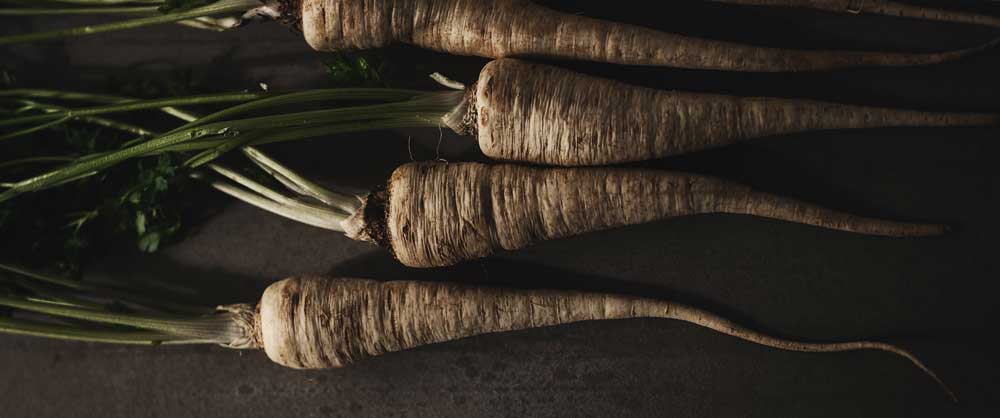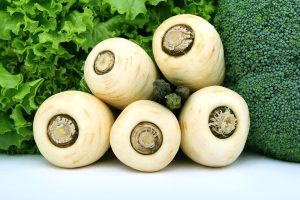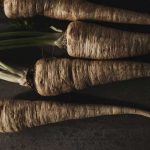We use cookies to make your experience better. To comply with the new e-Privacy directive, we need to ask for your consent to set the cookies. Learn more.
January Seasonable table - Parsnips
 Parsnips are a very reliable winter root vegetable. They have a distinct nutty flavour and sweetness and are very versatile in the kitchen. In Roman times they were believed to be an aphrodisiac and they were often used as a source of sugar before cane and beet sugars were available. Parsnips are a member of the cow parsley family along with carrot, dill, fennel and parsley. Treat as carrots in your rotation.
Parsnips are a very reliable winter root vegetable. They have a distinct nutty flavour and sweetness and are very versatile in the kitchen. In Roman times they were believed to be an aphrodisiac and they were often used as a source of sugar before cane and beet sugars were available. Parsnips are a member of the cow parsley family along with carrot, dill, fennel and parsley. Treat as carrots in your rotation.
How to Grow Parsnips
Sow parsnips from February to May. On light soils Tender and True are a very good variety whilst White Gem would be better for heavier soils. The seed has a short period of viability, so fresh seed should be purchased every year. Parsnips are slow to germinate and you are much more likely to succeed with growing them if you wait until April before sowing . If you can, wait until soil temperatures have reached a steady 10-12°C . Sow thinly or sow three seeds at 15cm intervals, 12mm deep in rows 30cm apart. When the seedlings are about 2.5cm high thin out leaving one seedling 15cm apart. Parsnips enjoy an open, sunny site and are easiest on a deep, light soil. When preparing the soil try and remove as many stones as possible for nice straight roots. An application of well rotted farm yard manure or a suitable NPK fertilizer will ensure a good crop. You could sow radish seeds along with the parsnips, they will mark the row and keep the crust from hardening, making life a little easier for the parsnip pushing through. As the radishes become of edible size, use them and weed and thin the parsnip seedlings to stand 15cm apart. Keep the soil weed free, hand weeding close to the roots to avoid damage. Keep the soil evenly moist to avoid roots splitting. Parsnip seeds take a relatively long time to germinate - about six weeks. Soaking the seed overnight may help to hasten germination. You can try sowing parsnips in toilet roll tubes filled with compost in the greenhouse – this means that you have control over temperature and moisture levels so are in with a better chance of success! Once the young parsnips have become established you can harden the plants off and plant the whole parsnip/compost/cylinder into its final position.
Parsnip seeds take a relatively long time to germinate - about six weeks. Soaking the seed overnight may help to hasten germination. You can try sowing parsnips in toilet roll tubes filled with compost in the greenhouse – this means that you have control over temperature and moisture levels so are in with a better chance of success! Once the young parsnips have become established you can harden the plants off and plant the whole parsnip/compost/cylinder into its final position.
Harvesting Parsnips
Parsnips are ready to lift when the foliage starts to die down in late summer or autumn; use a fork to carefully lift them. They can be left in the soil and lifted as required, although lifting a few extra in November will ensure you still have parsnips to eat even if the soil is frozen. Lightly frosted roots tend to produce the best flavour.Pests and diseases to watch for in Parsnips
Parsnip canker: This orange, brown or purple-coloured rot usually starts at the top of the root. It is mostly caused by drought, over-rich soil or damage to the crown. Improving drainage, rotating crops and earthing up the parsnips can all help in canker control. Take care when hoeing so as not to damage the crown. Carrot root fly : Parsnips don't suffer from root fly as much as carrots so is unlikely to be a problem unless carrot fly is very common in your garden. To prevent the root fly reaching the parsnips cover the crop with an insect proof mesh.Cooking Parsnips
[caption id="attachment_1799" align="alignright" width="300"] Pan fried parsnips and steak[/caption]
Parsnips are the main stay of winter cooking - stars of soups and roasts with their lovely nutty taste. Simple is often best - sliced and pan fried in butter to accompany steak is very good.
Pan fried parsnips and steak[/caption]
Parsnips are the main stay of winter cooking - stars of soups and roasts with their lovely nutty taste. Simple is often best - sliced and pan fried in butter to accompany steak is very good.
Nutrition in Parsnips
These versatile vegetables contain high levels of potassium, manganese, magnesium, phosphorous, zinc, and iron, in addition to vitamins B, C, E, and K. Parsnips also have high levels of fibre and protein.- The high levels of potassium will improve heart health. Potassium acts as a vasodilator and reduces blood pressure, as well as stress on the heart. The high levels of folate reduce homocysteine levels in the blood, which are generally associated with a higher risk of heart diseases.
- Parsnips have a high soluble fibre content. Soluble fibre is closely associated with reducing cholesterol levels (further boosting heart health) and with a lower chance of developing diabetes.
- The folate in parsnips is connected with reducing neural tube birth defects in infants and optimizing metabolic processes related to energy production and the nervous system.
- Parsnips can also help with weight loss.
Shopping list White Gem Seeds Tender and True Seeds Insect Proof Net NPK Fertilizer

